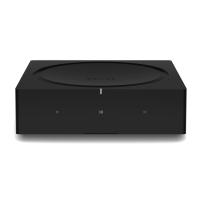3. Connect the optical adapter to the TV’s optical digital OUT port.
Note: The optical adapter’s port is “D-shaped”—make sure the connector aligns correctly into the
port. Inserting the adapter incorrectly may damage the cable.
You’ll use our app to set up and control your Sonos system. If you don’t have the Sonos app,
download it from your app store. See Controls and lights.
Line-in
Connect an external source like a phono preamp (your turntable may have a built-in phone preamp),
or other audio device. Learn more.
Change from stereo to mono
Amp plays audio in stereo by default. You can change the sound settings for the room associated
with the Amp so that it plays in two mono channels when playing music.
Specifications
Feature Description
Audio
Amplifier Class-D digital amplifier
Amplifier power 125W/Ch into 8 ohms
Speaker Connections Banana plugs (2)
Line-In Sources Supported Audio device with analog RCA output or optical output (optical
adapter required). TV device with HDMI ARC or optical output
(optical adapter required).
Subwoofer Output Auto-detecting RCA type, adjustable crossover
Networking
Wireless Connectivity Connects to your home WiFi network with any 802.11 b/g/n router.
802.11n only network configurations are not supported—you can
either change the router settings to 802.11 b/g/n or connect a
Sonos product to your router.
Ethernet Ports Dual Ethernet ports can connect Amp to a wired home network and
allow for connection of additional Sonos players.
General
System Requirements Passive speakers with speaker wire, broadband internet, and Sonos
app.
Power Supply Auto-switching 100-240V, 50-60 Hz AC universal input.

